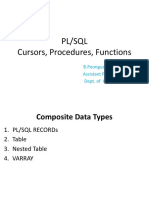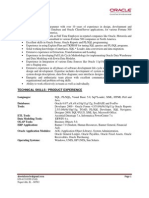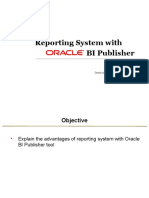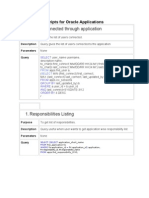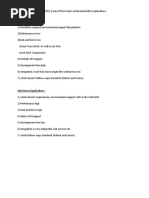PLSQL Cursor
Uploaded by
hkPLSQL Cursor
Uploaded by
hkPL/SQL Cursor :-
When an SQL statement is processed, Oracle creates a memory area
known as context area or work area. This work area is private to SQL’s operations. A
Cursor is a pointer to this context area. It contains all information needed for
processing the statement. In PL/SQL, the context area is controlled by Cursor. A cursor
contains information on a select statement and the rows of data accessed by it. It allows
user to access the stored information in it. The major
function of a cursor is to retrieve data, one row at a time, from a result set. Cursors
are used when the user needs to update records in a singleton fashion or in a row by row
manner, in a database table. The Data that is stored in the Cursor is called the Active
Data Set.
Types of cursor :-
1. Implicit cursor
2. Explicit cursor
1.) Implicit cursor :- If the Oracle engine opened a cursor for its internal processing
it is known as an Implicit Cursor. The implicit cursors are automatically generated
by Oracle while an SQL statement is executed. These are created by default to
process the statements when DML statements like INSERT, UPDATE, DELETE etc. are
executed.
2.) Explicit cursor :- Auser-defined cursor is known as an Explicit Cursor. An
explicit cursor is defined in the declaration section of the PL/SQL Block. It is
created on a SELECT Statement which returns more than one row.
Syntax :-
DECLARE
CURSOR <cursor_name> IS <SELECT statement^>
<cursor_variable declaration>
BEGIN
OPEN <cursor_name>;
FETCH <cursor_name> INTO <cursor_variable>;
……..
/* process the records;*/
………
. CLOSE <cursor_name>;
END;
There are four steps in using an Explicit Cursor :-
1.) DECLARE :- Declare the cursor in the Declaration section.It defines the cursor with
a name and the associated SELECT statement.
2.) OPEN :- It is used to allocate memory for the cursor and make it easy to fetch
the rows returned by the SQL statements into it.
3.) FETCH :- It is used to access one row at a time.
4.) CLOSE :- Once all the record is fetched now, we need to close the cursor so that
the memory allocated to this context area will be released. It is used to release the
allocated memory.
CURSOR ATTRIBUTES : -
Both Implicit cursor and the explicit cursor has certain attributes that can be
accessed. These are as follows –
%FOUND - It returns the Boolean result 'TRUE' if the most recent fetch operation
fetched a record successfully, else it will return FALSE.
%NOTFOUND - This works oppositely to %FOUND it will return 'TRUE' if the most
recent fetch operation could not able to fetch any record.
%ISOPEN - It returns Boolean result 'TRUE' if the given cursor is already opened,
else it returns 'FALSE'
%ROWCOUNT - It returns the numerical value. It gives the actual count of records that
got affected by the DML activity.
You might also like
- Oracle Database Administration Interview Questions You'll Most Likely Be Asked: Job Interview Questions SeriesFrom EverandOracle Database Administration Interview Questions You'll Most Likely Be Asked: Job Interview Questions Series5/5 (1)
- Compal LA-F951P DH5VF DH7VF DH53F DH73F REV 1A (1.0) - Acer Nitro AN515-52100% (5)Compal LA-F951P DH5VF DH7VF DH53F DH73F REV 1A (1.0) - Acer Nitro AN515-5267 pages
- 1.creating Cursor: This Step Allocates Memory: Types of CursorsNo ratings yet1.creating Cursor: This Step Allocates Memory: Types of Cursors7 pages
- PLSQL - Cursor Online Session Notes PDFNo ratings yetPLSQL - Cursor Online Session Notes PDF35 pages
- Making The Move From Oracle Warehouse Builder To Oracle Data Integrator 12No ratings yetMaking The Move From Oracle Warehouse Builder To Oracle Data Integrator 1219 pages
- I/O in PL/SQL: Managing Files Displaying Output To Screen Sending EmailNo ratings yetI/O in PL/SQL: Managing Files Displaying Output To Screen Sending Email44 pages
- UTL - FILE Program (HOW TO READ & WRITE File)No ratings yetUTL - FILE Program (HOW TO READ & WRITE File)6 pages
- TO Get The Associated With The: Responsbility Particular UserNo ratings yetTO Get The Associated With The: Responsbility Particular User14 pages
- Complete Installation and Configuration of Oracle Data IntegratorNo ratings yetComplete Installation and Configuration of Oracle Data Integrator33 pages
- 1 Stored Procedures in PL/SQL: 2.1 VariablesNo ratings yet1 Stored Procedures in PL/SQL: 2.1 Variables22 pages
- 431 Oracle PL-SQL Interview Questions Answers GuideNo ratings yet431 Oracle PL-SQL Interview Questions Answers Guide11 pages
- Oracle Database 11g SQL and PLSQL New FeaturesNo ratings yetOracle Database 11g SQL and PLSQL New Features232 pages
- Odi 3 (Oracle Data Integrator Interview Questions)No ratings yetOdi 3 (Oracle Data Integrator Interview Questions)3 pages
- Oracle PL SQL Developer Program Analyst in Chicago IL Resume Sheetal SoodNo ratings yetOracle PL SQL Developer Program Analyst in Chicago IL Resume Sheetal Sood6 pages
- Oracle 12c PL/SQL Workshop: Electronic PresentationNo ratings yetOracle 12c PL/SQL Workshop: Electronic Presentation16 pages
- BI Publisher Reporting System With: Edi YantoNo ratings yetBI Publisher Reporting System With: Edi Yanto61 pages
- ORACLE SQL, PL - SQL - Handling BULK EXCEPTIONNo ratings yetORACLE SQL, PL - SQL - Handling BULK EXCEPTION3 pages
- Introduction To Databases: Name: Akanksha SharmaNo ratings yetIntroduction To Databases: Name: Akanksha Sharma52 pages
- Gmail - PL - SQL Faq and Exception Handling... SET 1No ratings yetGmail - PL - SQL Faq and Exception Handling... SET 110 pages
- What Is PL/SQL?: PL/SQL Stands For Procedural Language Extension of SQLNo ratings yetWhat Is PL/SQL?: PL/SQL Stands For Procedural Language Extension of SQL25 pages
- Useful SQL Scripts For Oracle ApplicationsNo ratings yetUseful SQL Scripts For Oracle Applications15 pages
- PL/SQL FAQ - Oracle's Procedural Language Extension To SQL: What Is PL/SQL and What Is It Used For?No ratings yetPL/SQL FAQ - Oracle's Procedural Language Extension To SQL: What Is PL/SQL and What Is It Used For?14 pages
- Getting Started With MASM and Visual Studio 2012No ratings yetGetting Started With MASM and Visual Studio 201222 pages
- System 1: Optimization and Diagnostics SoftwareNo ratings yetSystem 1: Optimization and Diagnostics Software14 pages
- A Simple-To-Hard Step by Step Shell Scripting TutorialNo ratings yetA Simple-To-Hard Step by Step Shell Scripting Tutorial18 pages
- Learn Python 3 - Dictionaries Cheatsheet - CodecademyNo ratings yetLearn Python 3 - Dictionaries Cheatsheet - Codecademy3 pages
- Ex. 3 Image Acquisition With Guymager - Kali LinuXNo ratings yetEx. 3 Image Acquisition With Guymager - Kali LinuX7 pages





